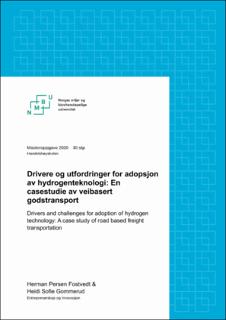| dc.contributor.advisor | Scholderer, Joachim | |
| dc.contributor.advisor | Holden, Erling | |
| dc.contributor.author | Fostvedt, Herman Persen | |
| dc.contributor.author | Gommerud, Heidi Sofie | |
| dc.coverage.spatial | Norway | en_US |
| dc.date.accessioned | 2020-09-25T11:06:13Z | |
| dc.date.available | 2020-09-25T11:06:13Z | |
| dc.date.issued | 2020 | |
| dc.identifier.uri | https://hdl.handle.net/11250/2679689 | |
| dc.description.abstract | This thesis goes through a qualitative integrated case study of drivers and challenges related to adoption of hydrogen technology in the Norwegian transportation industry. Through the thesis, we perform a deep dive in Norwegian transportation companies at different stages of adoption of hydrogen technology in an attempt to answer the problem statement:
“How does external and internal factors influence the adoption of hydrogen technology in today's Norwegian transportation industry?”
To answer the problem statement, companies’ perceptions, drivers and barriers have been analyzed through the three theoretical dimensions: organizational factors, external environment and technological characteristics. These are taken from the generic model “Technology Organization Environment” (TOE). The thesis uses the TOE model as a basis, and develops a new model for analysis of adoption of environmental technologies, which we hope can be of inspiration for further studies of adoption of sustainable technologies in the future.
The study has shown that the strongest drivers for adoption of hydrogen technology lies within organizational factors. The companies that have come the furthest has a clear environmentally strategic goal which is connected to the company’s pool of vehicles. These goals are also used actively by the leaders. This acts as a driver for adoption, but it is not a premisse. It has also been shown that an internal technology champion with the decision making power can trigger adoption.
Furthermore, we see a broad agreement across the informants that the external environment in the transportation industry is inhibiting adoption of hydrogen technology. The Norwegian transportation industry has high competition, low margins and low willingness to pay for environmentally friendly transportation. There is agreement that political incentives will be important to aid diffusion of hydrogen, but because the technology is relatively immature, only investment support for pilots and research projects has currently helped adoption. Other incentives have not yet had an effect. Nevertheless, going forward, the companies express the need for political incentives, and predictability in how these will develop over time.
Lastly, the study has shown that transportation companies have a positive attitude towards hydrogen technology, given that it will be available at a competitive price. Even the companies with the strongest organizational drivers see a large barrier to reduce the costs. It is difficult to invest in trucks without refueling facilities for hydrogen, and equally difficult to invest in refueling facilities without trucks (popularly named the “chicken and egg”-problem). In light of our analysis, we state that the “chicken and egg”-problem is best overcome by coordinating an effort to build hydrogen fuel stations in close proximity to areas with many large storage facilities which have long, regular distribution routes. | en_US |
| dc.description.abstract | Denne oppgaven tar for seg et kvalitativt integrert casestudie av drivere og utfordringer knyttet til adopsjon av hydrogenteknologi i transportbransjen. Gjennom oppgaven gjør vi et dypdykk i Norske transportbedrifter på forskjellige stadier av adopsjon av hydrogenteknologi med hensikt å besvare problemstillingen:
“Hvordan påvirker eksterne og interne faktorer adopsjon av hydrogenteknologi i transportbransjen i Norge i dag?”
For å besvare problemstillingen har de undersøkte bedriftenes oppfatninger, drivere og barrierer blitt analysert gjennom de tre teoretiske dimensjonene: organisasjonsmessige faktorer, eksterne rammebetingelser og teknologiske karakteristikker. Disse har utspring fra den generiske modellen “Technology Organisation Environment” (TOE). Oppgaven tar utgangspunkt i TOE og utvikler en ny analysemodell for adopsjon av miljøteknologier, som vi håper kan være av inspirasjon for å studere andre bærekraftige teknologier og bærekraftig innovasjon i fremtiden. | en_US |
| dc.language.iso | nob | en_US |
| dc.publisher | Norwegian University of Life Sciences, Ås | en_US |
| dc.rights | Attribution-NonCommercial-NoDerivatives 4.0 Internasjonal | * |
| dc.rights.uri | http://creativecommons.org/licenses/by-nc-nd/4.0/deed.no | * |
| dc.subject | Technology Organization Environment | en_US |
| dc.subject | TOE | en_US |
| dc.subject | Transportation industry | en_US |
| dc.title | Drivere og utfordringer for adopsjon av hydrogenteknologi : en casestudie av veibasert godstransport | en_US |
| dc.title.alternative | Drivers and challenges for adoption of hydrogen technology : a case study of road based freight transportation | en_US |
| dc.type | Master thesis | en_US |
| dc.source.pagenumber | 66 | en_US |
| dc.description.localcode | M-EI | en_US |

